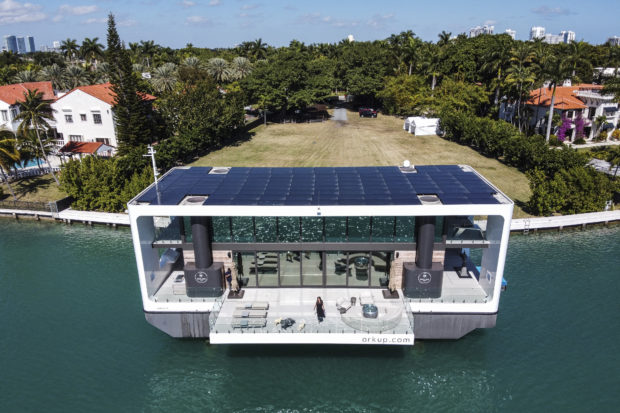Flood-prone Miami to spend billions tackling sea level rise

The Arkup luxury floating villa is docked at Star Island in Miami Beach, Florida, on February 5, 2021. Miami residents are used to seeing this houseboat. It usually docks near the harbor, although it has also appeared in Biscayne Bay. It costs $5.5 million and fits in with the rising sea levels that are sinking Florida. “It looks like a house, but technically it’s a boat,” says Nicolas Derouin, co-founder and managing director of Arkup, the Miami-based company that created this floating “villa” with a fold-out terrace over the sea. Photo by CHANDAN KHANNA / AFP
MIAMI — The US city of Miami is to invest billions of dollars to tackle its vulnerability to rising sea levels, a reality that already affects the daily lives of residents used to constant flooding.
Miami-Dade County Mayor Daniella Levine-Cava said Friday she will protect communities hardest hit by rising sea levels, which eat away at beaches and leave residents particularly vulnerable to flooding during hurricane season.
“We must continue to focus on restoration, preservation and protection of this sacred space,” she told a news conference.
“And so we will be together investing billions of dollars… in our infrastructure so that we can lift this community and others that are so affected by sea level rise,” she added.
She cited “adaptation action areas” as a first priority to be studied, which would include raising low-lying roads, and waterproofing and converting southern Florida’s widely used septic tanks into sewage systems.
The area, with extensive wetlands and sitting on porous stone that acts like a sponge, makes the state one of the most at risk from rising sea levels.
The problem is so visible that, during the summer rainy season, it is common to see Miamians kayaking along flooded avenues and cars sunk up to their windows.
The city of Miami Beach — which is part of Miami-Dade County — invested millions of dollars in raising the level of many of its streets in 2016.
And some private entrepreneurs have proposed creative, if expensive, ways to adapt to the challenge.
For example, Miami residents are used to seeing a houseboat that often docks near the port, although it has also appeared in other waters around Biscayne Bay.
It is valued at $5.5 million and adjusts to rising sea levels.
“It looks like a house, but technically it’s a boat,” said Nicolas Derouin, co-founder and managing director of Arkup, the Miami-based company that created this floating “villa” with a drop-down terrace over the sea.
The house, covered with a roof of solar panels, remains stable thanks to four hydraulic pillars that fix it to an underwater bed.
The Environmental Protection Agency says the sea level could rise by 30 cm to 120 cm over the coming century.